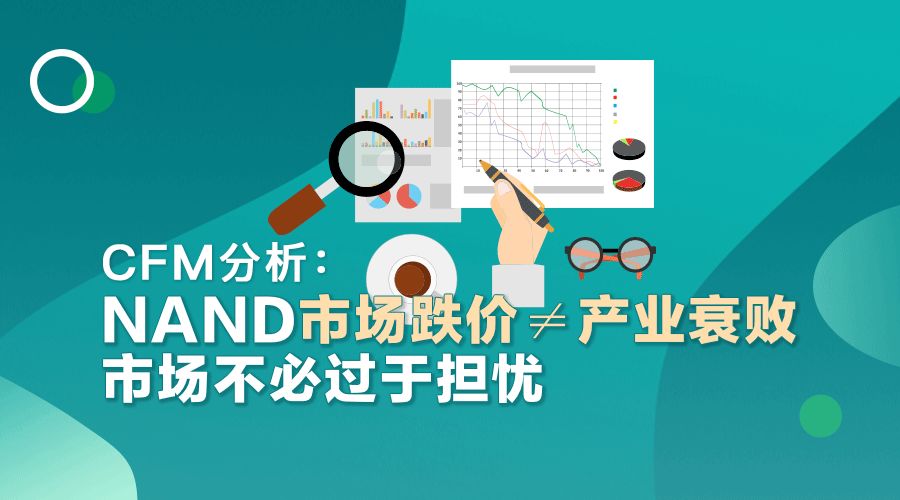Both DRAM and NAND Flash prices fell in the second half of 2018, but as of early Q4, the NAND Flash price index has accumulated a decline of up to 57%. In contrast, the decline in DRAM prices has slowed. However, the market is filled with a wait-and-see atmosphere, and DRAM suppliers have successively delayed capacity expansion. Looking ahead, Nanya Technology believes that overall market demand is not pessimistic and estimates that DRAM prices will not return to the historical sharp decline seen in the past, but will still undergo seasonal price adjustments, with a gradual decline expected over about 1 to 2 quarters.
The memory industry has experienced significant fluctuations in NAND Flash market prices since 2018, following about two years of prosperity. In particular, manufacturers have continuously expanded the production of 64-layer/72-layer 3D NAND, with major companies such as Samsung, Toshiba/Western Digital, and Micron/Intel accounting for over 80% of 3D NAND production. However, the influx of substandard products has disrupted market order and intensified overall capacity surplus competition. Even during the traditional peak season in Q3, the trend of declining NAND Flash prices could not be reversed. According to China Flash Market, the price of NAND Flash has dropped to $0.1 per GB, with a cumulative decline exceeding 50% as of October 2018.
Although DRAM suppliers have been relatively slow in expanding capacity, they began to increase wafer production starting in Q3, and new capacity is gradually coming online from Q4 to Q1 2019, impacting overall industry supply. On the other hand, due to tariffs from the US-China trade war and CPU shortages, the momentum for orders in Q4 has significantly slowed, especially in the PC market, which has been most affected by CPU shortages. Additionally, substandard DRAM products have begun to impact spot market prices, putting short-term market prices under pressure.
Nanya Technology’s General Manager, Li Peiying, stated that overall supply and demand in Q4 2018 remains stable, with the server and mobile phone markets still healthy, and demand for consumer electronics also being decent. Only the PC market is experiencing an oversupply of DRAM.
Li Peiying pointed out that although market demand is relatively conservative, suppliers have begun to delay capacity expansion and capital expenditures starting in Q4. Since DRAM suppliers are still rationally controlling output, coupled with a not overly pessimistic demand outlook, it is expected that while there will be seasonal fluctuations in 2019, there should not be a sharp price drop. The quarterly decline is unlikely to exceed double digits, thus DRAM prices in 2019 will show a reasonable adjustment range, continuing to decline gradually over about 1 to 2 quarters.
Li Peiying believes that the key factors affecting the market in 2019 will be the international situation, especially the uncertainty of the US-China trade war. Due to increased tariffs, assembly plant customers located in mainland China will be directly or indirectly affected and will need to take some countermeasures, such as relocating assembly lines to other countries, thus requiring an adjustment transition period.
Li Peiying further stated that with dual-camera smartphones becoming mainstream, future specifications will focus on multi-camera setups. The differentiation of smartphone products will mainly rely on upgrades in memory specifications. It can be seen that although smartphone shipment volumes have not grown, the memory capacity used has increased, with Android flagship models typically featuring 6GB to 8GB, while Apple’s new OLED models have introduced 4GB.
In terms of servers, the demand for cloud services and various industries for servers continues to grow, with the mainland market’s server demand increasing by 23% year-on-year, and the demand from the four major data centers in North America steadily growing. Globally, server demand is increasing by about 11% annually, with average memory capacity continuing to rise, and total demand for server memory increasing by over 30% year-on-year.
As for consumer electronic terminal products, televisions, set-top boxes, smart speakers, and SSDs remain key market segments, and the new generation of smartwatches, which provide ECG functions, is expected to drive growth in future wearable devices.
From a long-term perspective on DRAM development, Li Peiying believes that future global electronic products will move towards intelligence, and memory will inevitably become the most critical component. There are no overly pessimistic reasons for overall demand, but changes in the international situation will be the most important influencing factor.
Source: DIGITIMES
China Flash Market Price Analysis

Click the lower left corner “Read the original text”